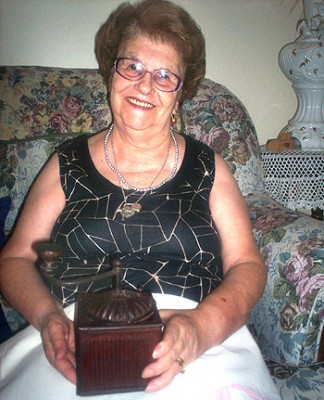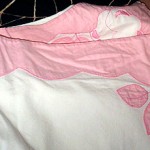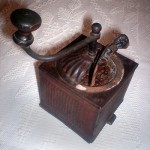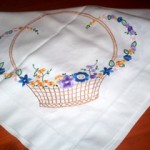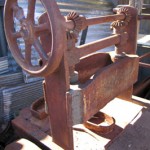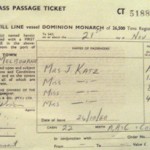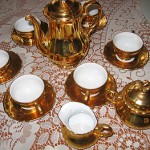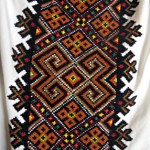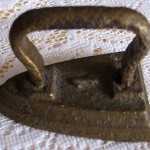Italian
Burgos, Sardinia, Italy
Genoa, Italy on 17 January 1959
Sydney on 17 February 1959
Brother’s home in Stanmore, Sydney then Cooma in south-eastern New South Wales with my husband.
Home duties whilst my husband worked on the Snowy Mountains Hydro scheme.
I worked in my husband’s joinery shop in Leeton [Riverina, NSW] for 2 weeks before he kicked me out for giving everything away!
I left Burgos, Sardinia, Italy from Genoa. I was 29 years old and I boarded the Oceania in January and I arrived in Sydney, 17 February 1959.
I came to Australia to meet up with my fiancé, Felix. We had been engaged for seven years; five years before he came to Australia and he was two years on his own. When you love someone and you have known him for a long time, you go wherever he is. He was a beautiful person, he was honest and intelligent. I was not scared to follow him to the other side of the world. I didn’t think about the dangers or all the things that might happen to me. If I did know, I would not have gotten on the ship!
I packed my glory box with everything I might need. My godmother made the tablecloth with the flower baskets for me. The coffee grinder has a metal cap where the coffee beans go and then the bottom is wooden and it holds the ground coffee. All my cooking pots and most important, my wedding dress; my mother helped me get as much in as possible.
I [also] brought the handmade sheet sets, the ones with the pink embroidery I made while I was still in Sardinia. I would mark the design of the edging first, then stitch the coloured material into the pattern and then I would iron it and then start the special stiches called punti rodi, punti peno and punti delba. It would have taken maybe a month or more to make it. I would sit outside with my family and ladies next door, and do my sewing.
On the ship, I was in a dormitory room with 11 other ladies. I knew one of the girls and she went on the top bunk, but she was getting seasick during the night so I told her to let me go in the top bunk so she wouldn’t throw up on me! All the girls were going to Australia to get married, some to Melbourne, to Perth and Sydney. I still keep in contact with the one girl who stayed in Perth; we ring each other once or twice a year.
During the journey the other girls were having a good time but I was too scared to get out of the cabin besides going to meals. I didn’t think it was appropriate for me to be wandering around the ship as a lady who was engaged. The captain of the boat was from Sardinia and recognised my surname on the passenger list and asked me to join him for dinner. That was lovely and I felt a bit better but still did not want to walk around the ship.
Not all the girls knew the men they were going to marry, so before we got off the ship they made us wear tags with the name of the camp in Victoria – Bonegilla – just in case the men didn’t meet us.
I didn’t have to pay for my passage because it was part of the deal the government had with Felix. He was one of the skilled carpenters who were working on the Snowy Mountains hydro scheme. [He] came to Australia because when he came to work for my father [in Italy] he became aware that my brother, who was in Australia, was sending money back to the family. As Felix was the eldest of 14 children, he took advantage of the Australian Government’s calls for skilled workers in the early 1950s. Felix said he wanted to marry [me] and that he would go to make some money to set [us] up.
He was helping to build one of the dams. Before he started this job, he tried to get work in Sydney and Felix stayed with my brother who lived at Stanmore in Sydney. Felix heard that they were looking for workers for the Snowy Mountains hydro scheme and he had to go to tech[nical college]. They checked if he could follow plans and he passed, so he got the job in Cooma.
As I was getting into Sydney, I was worried that I had a lot of jewellery with me because one of the girls said that they would take it away from me if I have too much. I didn’t know what to do, so I decided to sew the jewellery into the back of my underpants!
When I got off the ship I could not see Felix but I could see someone waving at me. When I looked hard, it was my brother. I hadn’t seen him for seven years. Felix was late coming from Cooma, which was three hours away from Sydney. He was flying in on a little plane.
When I went through Customs they were only worried about the terronne (Italian noughat). I kept saying, “Torte, torte”. My brother saw me and jumped the fence to help. He explained to Customs that it was a sweet we were having for my wedding and I was able to go. While all this was going on, Felix arrived. Felix had flowers for me and when we went to get in the taxi I had to explain why I couldn’t sit down properly! I stayed with my brother at his home in Stanmore.
I arrived on a Tuesday and was married on the Saturday. We did not have a big wedding, there were about a dozen people. We married in St. Fiacre Catholic Church, 98 Catherine Street in Leichhardt. After we went back to my brother’s house and had cut sandwiches, peanuts, the terronne and little cakes.
I actually went to Cooma for our honeymoon on the little plane that bought Felix to Sydney and it was stormy and I was frightened and I didn’t like it at all. I didn’t know anyone in Cooma and did not want to live there and asked Felix to take me back to Sydney, which he did. We bought a house in Stanmore that we fixed up and stayed there for the next 18 years. Felix did sub-contracting for kitchens and cabinet making with my brother all over Sydney.
When I had my first baby at Stanmore Base Hospital, I didn’t know what to expect like any new mother. So when I started to have pains, Felix took me to the hospital to be checked. When they had finished checking me, I got up to go home. They had to stop me because I thought because the pains had stopped I had finished. The nurses had to tell me the pains would come back in a couple of minutes. I didn’t know English well at that time and when the pains started again I would say, “Mama Mia, Mama Mia”, and the nurses would mimic me and sing, “Mama Mia, Mama Mia”! I was blessed to have two children; a daughter, Maria, and then a son, Frank.
At my wedding I met German lady name[d] Erica. She was a baby nurse and she had a baby of her own. She came to live with us. I remember one day Maria nearly died in her bath and Erica helped me. She showed me how to put the nappies on the line, how to fold them, all sorts of things. She could speak a little bit of Italian and English and she would teach me how to say things. We still keep in contact today; she now lives in the north of Australia. I was also lucky to find a neighbour who helped me lot as well.
I first found communicating very difficult and frustrating and after coming home crying after trying to buy some baby clothes, I put in my mind that I have to learn this language. Sooner or later I would have to. I would try and put two words together at first but I was determined. It took me a lot of years but I can now communicate and do the things I need to.
My mother and father came to Australia in 1966 as all their children had come to live in Australia. They lived in Stanmore close to me. It was nice to have my mother and father near me. They even helped us clean bricks so that we could make a fence and gate. It is still there today. Felix’s brother ended up buying that house. Dad could not speak any English but he had a trade. He was a carpenter and found a job in a factory do[ing] bits and pieces.
We came to Leeton in the Riverina region [of New South Wales] in 1977. My mother had a slight stroke and my sister Caterina was living in Leeton and thought that Leeton Hospital could look after her better. Mum travelled by ambulance from Sydney to Leeton and unfortunately went into a coma for a week.
In that time Felix was looking around Leeton and found that Mr Mirrabelli was selling his joinery business. Felix had always wanted his own business and asked about it. Mr Mirrabelli was unwell and the deal did not happen for six months, but that was the start of Felix Joinery [at] Railway Avenue in Leeton.
The first place we lived in Leeton was in Sycamore Street, which was owned by Mrs Ciccia, just behind the main street. The house had been closed for two years so my father helped us clean it up. We stayed there for a couple of years and when the house next to the joinery came up for sale, we bought it. I worked in the shop for about two weeks and Felix kicked me out because I would give everything away!
When I first came to Leeton it was winter and I remember I went into town in my fur coat. Not knowing anyone, I would say hello to everyone. The locals could not believe I would wear such a coat to town. To church or wedding, but not to go shopping! I had bought the coat in Italy and one person pinched me to see if it was real or fake. I found very good friends after a while and they were very generous. They would bring us eggs, vegies, fruit, watermelons. We settled well and the business was a success.
I adored my mother-in-law and they cared about me too. My mother-in-law and Felix’s brother came out to Australia. They lived in Leeton with us for six months and they spent four months in Sydney for a holiday and then went back to Italy. When she arrived, she wore the top half of the Sardinian national costume which had the most beautiful shawl. When Felix passed away, I draped his coffin with it because I knew he would love to have something of her with him.
I have many friends and my sister and [her] husband live in Leeton as well. My children have married and I have four grandchildren.
I still use the coffee grinder I brought over from Italy many years ago. The smell is wonderful. Although I don’t use my godmother’s tablecloth much now, I used it a lot over the years. It is very sentimental to me now. It reminds me of my godmother and it is still beautiful.


